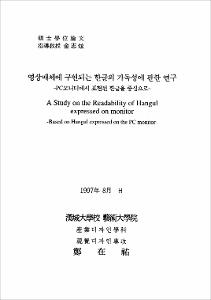영상매체에 구현되는 한글의 가독성에 관한 연구
- Files in This Item:
-
-
Download
 000000065932.pdf
기타 데이터 / 1.79 MB / Adobe PDF
000000065932.pdf
기타 데이터 / 1.79 MB / Adobe PDF
-
Items in Repository are protected by copyright, with all rights reserved, unless otherwise indicated.
 000000065932.pdf
기타 데이터 / 1.79 MB / Adobe PDF
000000065932.pdf
기타 데이터 / 1.79 MB / Adobe PDFItems in Repository are protected by copyright, with all rights reserved, unless otherwise indicated.